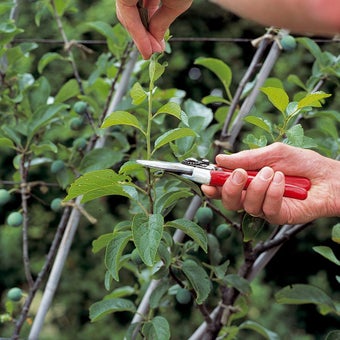
Quick facts
Plums grow best in sunny, sheltered spots
Only one tree is usually needed for a good crop
Choose from culinary and dessert cultivars
Practical considerations
Site: Plums need a warm and sheltered position to set fruit and crop well. Choose a south- or west-facing spot out of the wind, if you can. Alternatively, try fan training.
Garden size: If size is no restriction, choose a standard tree. However, a pyramid-trained tree usually proves the most economical on space and crops well. Alternatively, train as fans flat against a sunny wall or fence. Unlike some other fruits very dwarfing rootstocks are not available.
Dessert (eating) or culinary (cooking): Plum and gages are either dessert or culinary, although some are dual-purpose. Damsons are usually cooked or turned into jam.
Storage: Plums develop their best flavour if left to ripen on the tree. Unfortunately, the fruit does not store for long, so must be eaten or preserved.
Taste: Flavour is one of the important consideration for most gardeners. There is a guide to taste under the ‘quality’ category listed below for each cultivar. However, you may be able to try plums for yourself at fruit events.
Disease resistance: Resistance to disease is another consideration which varies between cultivars, with modern types often having higher levels of resistance than traditional ones.
Pollination group: It is generally much easier to get good pollination with plums, gages and damsons than with apples and pears. This is because many are self-fertile and, as a result, it is possible to grow just one tree. However, they will benefit from cross pollination of another tree in the same pollination group, or an adjacent one.
Partly self-fertile and self incompatible cultivars need cross-pollination with another tree in the same pollination group, or adjacent groups.
Rootstocks: Most tree fruits are grafted onto rootstocks. It is the rootstock, more than anything else, which controls the size of the tree. Pixy is a useful rootstock for pyramid-grown cultivars as it has a certain amount of dwarfing effect. St Julian A is vigorous, but is more reliable option where conditions are not optimal.
Cultivar selection
Plums, gages and damsons are closely related. Plums are large, usually soft-fleshed – perfect for eating or cooking (depending on the cultivar). Gages are small, round and sweet, but grow best in a sunny spot. Damsons are especially hardy and have a spicy, tart flavour and are good cooked and jammed. The most useful cultivars to grow in a garden are listed below.
Cultivars marked partly self-fertile and self incompatible need cross-pollination with another tree in the same pollination group, or adjacent groups.
Dessert (eating) cultivars
Name:Blue Tit AGM
Group: Plum
Pollination group: Self-fertile
Season of use: Mid-August
Quality: Good, but not especially sweet
Comments: Greenish-yellow fruits; reliable, compact.
Name:Cambridge Gage
Group: Gage
Pollination group: Partly self-fertile
Season of use: Late August to early September
Quality: Excellent
Comments: Green fruits, sweet; most reliable of the gages, but vigorous and needs a warm garden.
Name:Imperial Gage (Denniston’s Superb) AGM
Group: Gage
Pollination group: Self-fertile
Season of use: Late August
Quality: Good
Comments: Greenish-yellow fruits; reliable.
Name:Jefferson AGM
Group: Gage
Pollination group: Self incompatible
Season of use: Late August to early September
Quality: Excellent
Comments: Yellow-green fruits with fibrous flesh.
Name:Opal AGM
Group: Plum
Pollination group: Self-fertile
Season of use: Early August
Quality: Good
Comments: Orange-red fruits; very reliable.
Name:Oullins Gage AGM
Group: Gage
Pollination group: Self-fertile
Season of use: Mid-August
Quality: Fair
Comments: Greenish-yellow fruits.
Name:Victoria AGM
Group: Plum
Pollination group: Self-fertile
Season of use: Late August to early September
Quality: Good (dual-purpose as can be cooked)
Comments: Orange-red fruits.
Culinary (cooking) cultivars
Name: Belle de Louvain
Group: Plum
Pollination group: Self-fertile
Season of use: Late August
Quality: Good
Comments: Compact tree; very large red fruits.
Name:Czar AGM
Group: Plum
Pollination group: Self-fertile
Season of use: Early August
Quality: Good
Comments: Compact tree; reliable; blue fruits.
Name:Marjorie’s Seedling AGM
Group: Plum
Pollination group: Self-fertile
Season of use: September
Quality: Fair (Dual purpose – culinary and dessert)
Comments: Heavy cropping; blue fruits.
Name:Pershore AGM
Group: Plum
Pollination group: Self-fertile
Season of use: Mid-August
Quality: Fair
Comments: Compact tree; canary yellow medium size fruits.
Damson cultivars
Name:Farleigh
Group: Damson
Pollination group: Self-fertile
Season of use: Mid-September
Quality: Good
Comments: Compact tree; blue-black fruits.
Name: Prune Damson AGM
Group: Damson
Pollination group: Self-fertile
Season of use: September to October
Quality: Good
Comments: Long, oval blue-black fruits; vigorous but neat tree.
Links
RHS AGM Fruit (Adobe Acrobat pdf)
RHS Find a Plant





